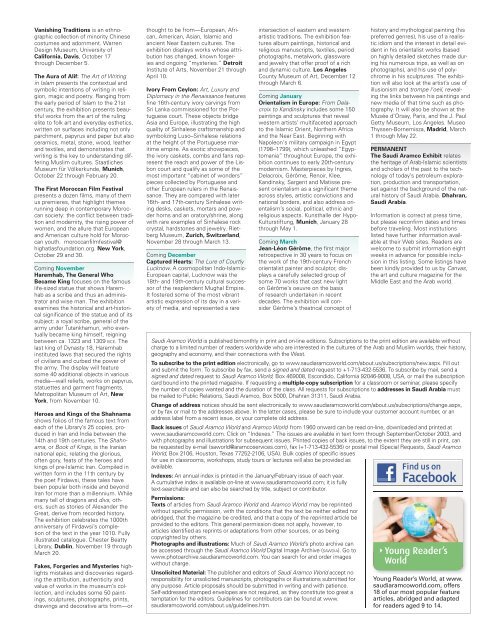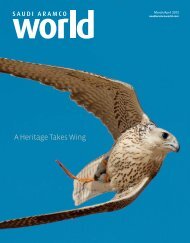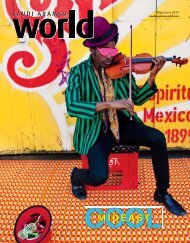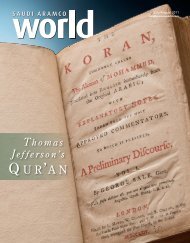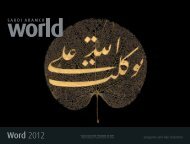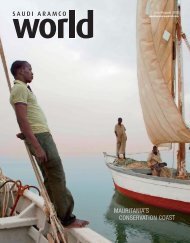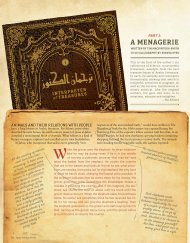ArabicintheSky - Saudi Aramco World
ArabicintheSky - Saudi Aramco World
ArabicintheSky - Saudi Aramco World
Create successful ePaper yourself
Turn your PDF publications into a flip-book with our unique Google optimized e-Paper software.
Vanishing Traditions is an ethnographic<br />
collection of minority Chinese<br />
costumes and adornment. Warren<br />
Design Museum, University of<br />
California, Davis, October 17<br />
through December 5.<br />
The Aura of Alif: The Art of Writing<br />
in Islam presents the contextual and<br />
symbolic intentions of writing in religion,<br />
magic and poetry. Ranging from<br />
the early period of Islam to the 21st<br />
century, the exhibition presents beautiful<br />
works from the art of the ruling<br />
elite to folk art and everyday esthetics,<br />
written on surfaces including not only<br />
parchment, papyrus and paper but also<br />
ceramics, metal, stone, wood, leather<br />
and textiles, and demonstrates that<br />
writing is the key to understanding differing<br />
Muslim cultures. Staatliches<br />
Museum für Völkerkunde, Munich,<br />
October 22 through February 20.<br />
The First Moroccan Film Festival<br />
presents a dozen films, many of them<br />
us premieres, that highlight themes<br />
running deep in contemporary Moroccan<br />
society: the conflict between tradition<br />
and modernity, the rising power of<br />
women, and the allure that European<br />
and American culture hold for Moroccan<br />
youth. moroccanfilmfestival@<br />
highatlasfoundation.org. New York,<br />
October 29 and 30.<br />
Coming November<br />
Haremhab, The General Who<br />
Became King focuses on the famous<br />
life-sized statue that shows Haremhab<br />
as a scribe and thus an administrator<br />
and wise man. The exhibition<br />
examines the historical and art-historical<br />
significance of the statue and of its<br />
subject: a royal scribe, general of the<br />
army under Tutankhamun, who eventually<br />
became king himself, reigning<br />
between ca. 1323 and 1309 BCE. The<br />
last king of Dynasty 18, Haremhab<br />
instituted laws that secured the rights<br />
of civilians and curbed the power of<br />
the army. The display will feature<br />
some 40 additional objects in various<br />
media—wall reliefs, works on papyrus,<br />
statuettes and garment fragments.<br />
Metropolitan Museum of Art, New<br />
York, from November 10.<br />
Heroes and Kings of the Shahnama<br />
shows folios of the famous text from<br />
each of the Library’s 25 copies, produced<br />
in Iran and India between the<br />
14th and 19th centuries. The Shahnama,<br />
or Book of Kings, is the Iranian<br />
national epic, relating the glorious,<br />
often gory, feats of the heroes and<br />
kings of pre-Islamic Iran. Compiled in<br />
written form in the 11th century by<br />
the poet Firdawsi, these tales have<br />
been popular both inside and beyond<br />
Iran for more than a millennium. While<br />
many tell of dragons and divs, others,<br />
such as stories of Alexander the<br />
Great, derive from recorded history.<br />
The exhibition celebrates the 1000th<br />
anniversary of Firdawsi’s completion<br />
of the text in the year 1010. Fully<br />
illustrated catalogue. Chester Beatty<br />
Library, Dublin, November 19 through<br />
March 20.<br />
Fakes, Forgeries and Mysteries highlights<br />
mistakes and discoveries regarding<br />
the attribution, authenticity and<br />
value of works in the museum’s collection,<br />
and includes some 50 paintings,<br />
sculptures, photographs, prints,<br />
drawings and decorative arts from—or<br />
thought to be from—European, African,<br />
American, Asian, Islamic and<br />
ancient Near Eastern cultures. The<br />
exhibition displays works whose attribution<br />
has changed, known forgeries<br />
and ongoing “mysteries.” Detroit<br />
Institute of Arts, November 21 through<br />
April 10.<br />
Ivory From Ceylon: Art, Luxury and<br />
Diplomacy in the Renaissance features<br />
fine 16th-century ivory carvings from<br />
Sri Lanka commissioned for the Portuguese<br />
court. These objects bridge<br />
Asia and Europe, illustrating the high<br />
quality of Sinhalese craftsmanship and<br />
symbolizing Luso–Sinhalese relations<br />
at the height of the Portuguese maritime<br />
empire. As exotic showpieces,<br />
the ivory caskets, combs and fans represent<br />
the reach and power of the Lisbon<br />
court and qualify as some of the<br />
most important “cabinet of wonders”<br />
pieces collected by Portuguese and<br />
other European rulers in the Renaissance.<br />
They are compared with later<br />
16th- and 17th-century Sinhalese writing<br />
desks, caskets, mortars and powder<br />
horns and an oratory/shrine, along<br />
with rare examples of Sinhalese rock<br />
crystal, hardstones and jewelry. Rietberg<br />
Museum, Zurich, Switzerland,<br />
November 28 through March 13.<br />
Coming December<br />
Captured Hearts: The Lure of Courtly<br />
Lucknow. A cosmopolitan Indo-Islamic-<br />
European capital, Lucknow was the<br />
18th- and 19th-century cultural successor<br />
of the resplendent Mughal Empire.<br />
It fostered some of the most vibrant<br />
artistic expression of its day in a variety<br />
of media, and represented a rare<br />
intersection of eastern and western<br />
artistic traditions. The exhibition features<br />
album paintings, historical and<br />
religious manuscripts, textiles, period<br />
photographs, metalwork, glassware<br />
and jewelry that offer proof of a rich<br />
and dynamic culture. Los Angeles<br />
County Museum of Art, December 12<br />
through March 6.<br />
Coming January<br />
Orientalism in Europe: From Delacroix<br />
to Kandinsky includes some 150<br />
paintings and sculptures that reveal<br />
western artists’ multifaceted approach<br />
to the Islamic Orient, Northern Africa<br />
and the Near East. Beginning with<br />
Napoleon‘s military campaign in Egypt<br />
(1798–1799), which unleashed “Egyptomania”<br />
throughout Europe, the exhibition<br />
continues to early 20th-century<br />
modernism. Masterpieces by Ingres,<br />
Delacroix, Gérôme, Renoir, Klee,<br />
Kandinsky, Sargent and Matisse present<br />
orientalism as a significant theme<br />
across styles, artistic convictions and<br />
national borders, and also address orientalism’s<br />
social, political, ethnic and<br />
religious aspects. Kunsthalle der Hypo-<br />
Kulturstiftung, Munich, January 28<br />
through May 1.<br />
Coming March<br />
Jean-Léon Gérôme, the first major<br />
retrospective in 30 years to focus on<br />
the work of the 19th-century French<br />
orientalist painter and sculptor, displays<br />
a carefully selected group of<br />
some 70 works that cast new light<br />
on Gérôme’s oeuvre on the basis<br />
of research undertaken in recent<br />
decades. The exhibition will consider<br />
Gérôme’s theatrical concept of<br />
history and mythological painting (his<br />
preferred genres), his use of a realistic<br />
idiom and the interest in detail evident<br />
in his orientalist works (based<br />
on highly detailed sketches made during<br />
his numerous trips, as well as on<br />
photographs), and his use of polychrome<br />
in his sculptures. The exhibition<br />
will also look at the artist’s use of<br />
illusionism and trompe l’oeil, revealing<br />
the links between his paintings and<br />
new media of that time such as photography.<br />
It will also be shown at the<br />
Musée d’Orsay, Paris, and the J. Paul<br />
Getty Museum, Los Angeles. Museo<br />
Thyssen-Bornemisza, Madrid, March<br />
1 through May 22.<br />
PERMANENT<br />
The <strong>Saudi</strong> <strong>Aramco</strong> Exhibit relates<br />
the heritage of Arab-Islamic scientists<br />
and scholars of the past to the technology<br />
of today’s petroleum exploration,<br />
production and transportation,<br />
set against the background of the natural<br />
history of <strong>Saudi</strong> Arabia. Dhahran,<br />
<strong>Saudi</strong> Arabia.<br />
Information is correct at press time,<br />
but please reconfirm dates and times<br />
before traveling. Most institutions<br />
listed have further information available<br />
at their Web sites. Readers are<br />
welcome to submit information eight<br />
weeks in advance for possible inclusion<br />
in this listing. Some listings have<br />
been kindly provided to us by Canvas,<br />
the art and culture magazine for the<br />
Middle East and the Arab world.<br />
<strong>Saudi</strong> <strong>Aramco</strong> <strong>World</strong> is published bimonthly in print and on-line editions. Subscriptions to the print edition are available without<br />
charge to a limited number of readers worldwide who are interested in the cultures of the Arab and Muslim worlds, their history,<br />
geography and economy, and their connections with the West.<br />
To subscribe to the print edition electronically, go to www.saudiaramcoworld.com/about.us/subscriptions/new.aspx. Fill out<br />
and submit the form. To subscribe by fax, send a signed and dated request to +1-713-432-5536. To subscribe by mail, send a<br />
signed and dated request to <strong>Saudi</strong> <strong>Aramco</strong> <strong>World</strong>, Box 469008, Escondido, California 92046-9008, USA, or mail the subscription<br />
card bound into the printed magazine. If requesting a multiple-copy subscription for a classroom or seminar, please specify<br />
the number of copies wanted and the duration of the class. All requests for subscriptions to addresses in <strong>Saudi</strong> Arabia must<br />
be mailed to Public Relations, <strong>Saudi</strong> <strong>Aramco</strong>, Box 5000, Dhahran 31311, <strong>Saudi</strong> Arabia.<br />
Change of address notices should be sent electronically to www.saudiaramcoworld.com/about.us/subscriptions/change.aspx,<br />
or by fax or mail to the addresses above. In the latter cases, please be sure to include your customer account number, or an<br />
address label from a recent issue, or your complete old address.<br />
Back issues of <strong>Saudi</strong> <strong>Aramco</strong> <strong>World</strong> and <strong>Aramco</strong> <strong>World</strong> from 1960 onward can be read on-line, downloaded and printed at<br />
www.saudiaramcoworld.com. Click on “Indexes.” The issues are available in text form through September/October 2003, and<br />
with photographs and illustrations for subsequent issues. Printed copies of back issues, to the extent they are still in print, can<br />
be requested by e-mail (saworld@aramcoservices.com), fax (+1-713-432-5536) or postal mail (Special Requests, <strong>Saudi</strong> <strong>Aramco</strong><br />
<strong>World</strong>, Box 2106, Houston, Texas 77252-2106, USA). Bulk copies of specific issues<br />
for use in classrooms, workshops, study tours or lectures will also be provided as<br />
available.<br />
Indexes: An annual index is printed in the January/February issue of each year.<br />
A cumulative index is available on-line at www.saudiaramcoworld.com; it is fully<br />
text-searchable and can also be searched by title, subject or contributor.<br />
Permissions:<br />
Texts of articles from <strong>Saudi</strong> <strong>Aramco</strong> <strong>World</strong> and <strong>Aramco</strong> <strong>World</strong> may be reprinted<br />
without specific permission, with the conditions that the text be neither edited nor<br />
abridged, that the magazine be credited, and that a copy of the reprinted article be<br />
provided to the editors. This general permission does not apply, however, to<br />
articles identified as reprints or adaptations from other sources, or as being<br />
copyrighted by others.<br />
Photographs and illustrations: Much of <strong>Saudi</strong> <strong>Aramco</strong> <strong>World</strong>’s photo archive can<br />
be accessed through the <strong>Saudi</strong> <strong>Aramco</strong> <strong>World</strong> Digital Image Archive (SAWDIA). Go to<br />
www.photoarchive.saudiaramcoworld.com. You can search for and order images<br />
without charge.<br />
Unsolicited Material: The publisher and editors of <strong>Saudi</strong> <strong>Aramco</strong> <strong>World</strong> accept no<br />
responsibility for unsolicited manuscripts, photographs or illustrations submitted for<br />
any purpose. Article proposals should be submitted in writing and with patience.<br />
Self-addressed stamped envelopes are not required, as they constitute too great a<br />
temptation for the editors. Guidelines for contributors can be found at www.<br />
saudiaramcoworld.com/about.us/guidelines.htm.<br />
Young Reader’s<br />
<strong>World</strong><br />
Young Reader’s <strong>World</strong>, at www.<br />
saudiaramcoworld.com, offers<br />
18 of our most popular feature<br />
articles, abridged and adapted<br />
for readers aged 9 to 14.


